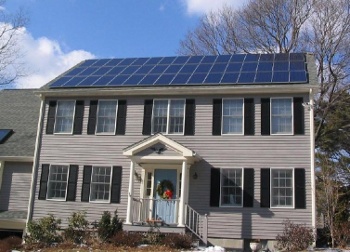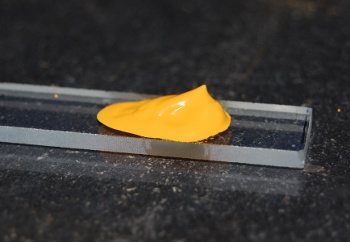Inexpensive Photovoltaics
January 17, 2012
For those of you who think that
residential solar power is a recent development, my colleagues and I were having lunchtime discussions about
photovoltaics in the late 1970s. The
efficiencies of these devices were low in those days, and the cost per installed
watt was absurdly high. Also, there was none of the present infrastructure that enables homeowners to "run the meter backwards" and sell power back to the electric company.
One of my colleagues, Alten Gilleo, was a
fellow of the
American Physical Society and a
Bell Labs veteran.[1] He was co-discoverer of the
ferrimagnetism of
yttrium iron garnet (YIG), an important electronic material.[2] When Alten talked, everyone listened, and he had an interesting analysis of the
economics of photovoltaics.
Land values in
Morris County, New Jersey, where we all lived, are quite high. Today, an
acre of land will cost anywhere from $250,000 to several million dollars. I can afford to live here only because my home is on a third acre lot in a less expensive
municipality. Alten's argument was that really efficient photovoltaics would still be expensive, since they take up land area. Let's look at the numbers.

Love on a rooftop?
Well, at least the electric part.
Photovoltaic panels on the roof of a residence near Boston, Massachusetts.
(Photo by Gray Watson, via Wikimedia Commons))
The average
insolation on the
Earth is 164 watts per
square meter when averaged over a 24 hour day. At
mid-latitudes (about 40 degrees) where I live, we can get as much as 600 watts per square meter in eight hours on a
summer's day. This would average a little more than 200 watts over 24 hours under these most favorable conditions, but we'll just stick with 164 watt/square meters.
An acre is 4,046.86 square meters, so we get an average insolation of about 650 kW in an acre. If we apply a photovoltaic efficiency of 1% (very low, but you'll read below why I use this number), that's 6.5 kW of harvested energy per acre. Since an average US
household uses about one kW, this is a nice number. However, it also means that the
capital cost of land to power a single household with 1% photovoltaics in my area is $40,000 - $385,000. Quite a bit more than the panel cost.
To be fair, most photovoltaic installations don't use land area, since they're installed on roofs. However, the projected
area of my roof, garage included, is just 1,500 square feet, or 140 square meters. One percent efficient photovoltaics covering the entire roof will produce just 230 watts, so some land area would be required to meet my electrical needs. The minimum efficiency for a photovoltaic tiled roof to meet all my electrical needs is about 5%.
Photovoltaics that are both inexpensive and efficient are being pursued by many research groups. A
paradigm change not forthcoming, there are two ways to do this; namely, start with efficient photovoltaics and make them less expensive, or start with inexpensive photovoltaics and make them more efficient. The later approach is being pursued by a research team at
Notre Dame University.[3-6] The team is led by
Prashant Kamat, a Professor of
Chemistry and Biochemistry and a member of its
Center for Nano Science and Technology.[5]
The Notre Dame team calls their novel photovoltaic method, "Sun-Believable." Says Kamat,[5]
"We want to do something transformative, to move beyond current silicon-based solar technology... By incorporating power-producing nanoparticles, called quantum dots, into a spreadable compound, we've made a one-coat solar paint that can be applied to any conductive surface without special equipment."[5]
Silicon is an expensive material, so many research teams are investigating photovoltaics based on
quantum dots of materials such as
lead sulfide (PbS). Although lead sulfide is inexpensive, the process of forming the quantum dots is slow and expensive.[4] The Notre Dame approach is based on quantum dots, also, but their dots are contained in a one-coat,
paintable material.
Cadmium sulfide (CdS),
cadmium selenide (CdSe) and
titanium oxide (titania, TiO
2)
semiconductor nanoparticles are dispersed in an
alcohol solution that's applied as a paste to
transparent conductors and
annealed at 473
K (200°C).[3] Coating of the titania nanoparticles with the
cadmium compounds is accomplished in two ways. The ingredients were just mixed together, or the CdS or CdSe are deposited on the titania particles by an
ionic layer
adsorption/
reaction method.
The nanoparticles are then placed in a water-alcohol solution to develop a paste that's brushed onto a transparent conductor. The
photovoltaic cell is completed with a
graphene-
Cu2S counter electrode and a sulfide/polysulfide
electrolyte. The open circuit
voltage was as high as 0.6 volts, and a short-circuit
current of 3.1 mA/cm
2 was achieved with
simulated solar radiation.[3]

The Notre Dame photovoltaic paint. Most artists would identify this as a mixture of cadmium yellow and cadmium orange pigments, which is not far from the truth.
(Notre Dame image, used with permission.))
The efficiency of these cells was 1%, whereas
silicon solar cells have efficiencies of 10-15%, so there's still need for improvement.[4, 6] It goes without saying that the Notre Dame group is working to increase the efficiency, but this proof of concept is a good first step. Another area for research is the long term stability of such cells.
A
YouTube video of the process is available,
here. The Notre Dame research was funded by the
US Department of Energy's Office of Basic Energy Sciences.[5]
References:
- J. J. Barrett and D. M. Gualtieri, "Obituary - M. A. Gilleo," Physics Today, vol. 34, no. 7 (July, 1981), p. 74.
- S. Geller and M.A. Gilleo, "Structure and Ferrimagnetism of Yttrium and Rare-Earth-Iron Garnets, Acta Cryst., vol. 10, no. 3 (March, 1957), p.239. A better quality page image is available, here.
- Matthew P. Genovese, Ian V. Lightcap and Prashant V. Kamat, "Sun-Believable Solar Paint. A Transformative One-Step Approach for Designing Nanocrystalline Solar Cells," ACS Nano, Article ASAP, DOI: 10.1021/nn204381g.
- Erika Gebe, "Solar Cells From A Paintbrush," C&E News, December 14, 2011.
- Arnie Phifer, "Notre Dame researchers develop paint-on solar cells," Notre Dame University Press Release, December 21, 2011.
- Dave Levitan, "Solar Paint is Easy to Make, Needs Efficiency Improvements," IEEE Spectrum, January 3, 2012.
- Painting Solar Cells with Nanoparticle Paste, YouTube Video, Uploaded by CENonline, December 16, 2011.
Permanent Link to this article
Linked Keywords: Residential; solar power; photovoltaic; energy conversion efficiency; watt; fellow; American Physical Society; Bell Labs; ferrimagnetism; yttrium iron garnet; economics; Morris County, New Jersey; acre; municipality; Love on a rooftop; Boston, Massachusetts; Gray Watson; Wikimedia Commons; insolation; Earth; square meter; mid-latitudes; summer; household; capital cost; area; paradigm change; Notre Dame University; Prashant Kamat; Chemistry and Biochemistry; Center for Nano Science and Technology; silicon; quantum dots; lead sulfide; paintable; cadmium sulfide; cadmium selenide; titanium oxide; titania; semiconductor; nanoparticle; alcohol; transparent; conductor; annealing; kelvin; K; cadmium; ionic; adsorption; reaction; photovoltaic cell; graphene; chalcocite; Cu2S; electrolyte; voltage; current; simulated solar radiation; cadmium_pigments; cadmium yellow; cadmium orange; silicon solar cells; YouTube; US Department of Energy; Office of Basic Energy Sciences.